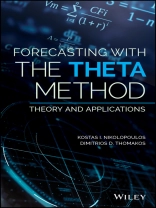The first book to be published on the Theta method, outlining under what conditions the method outperforms other forecasting methods
This book is the first to detail the Theta method of forecasting – one of the most difficult-to-beat forecasting benchmarks, which topped the biggest forecasting competition in the world in 2000: the M3 competition. Written by two of the leading experts in the forecasting field, it illuminates the exact replication of the method and under what conditions the method outperforms other forecasting methods. Recent developments such as multivariate models are also included, as are a series of practical applications in finance, economics, and healthcare. The book also offers practical tools in MS Excel and guidance, as well as provisional access, for the use of R source code and respective packages.
Forecasting with the Theta Method: Theory and Applications includes three main parts. The first part, titled Theory, Methods, Models & Applications details the new theory about the method. The second part, Applications & Performance in Forecasting Competitions, describes empirical results and simulations on the method. The last part roadmaps future research and also include contributions from another leading scholar of the method – Dr. Fotios Petropoulos.
* First ever book to be published on the Theta Method
* Explores new theory and exact conditions under which methods would outperform most forecasting benchmarks
* Clearly written with practical applications
* Employs R – open source code with all included implementations
Forecasting with the Theta Method: Theory and Applications is a valuable tool for both academics and practitioners involved in forecasting and respective software development.
สารบัญ
Author Biography ix
Preface xi
Part I Theory, Methods and Models 1
1 The -legacy 3
1.1 The Origins… 3
1.1.1 The Quest for Causality 5
1.2 The Original Concept: THETA as in THErmos TAt 6
1.2.1 Background: A Decomposition Approach to Forecasting 7
1.2.2 The Original Basic Model of the Theta Method 7
1.2.3 How to Build and Forecast with the Basic Model 10
1.2.4 SES with Drift 11
1.2.5 The Exact Setup in the M3 Competition 12
1.2.6 Implementing the Basic Version in Microsoft Excel 15
1.2.7 The Futu Re is Written in R 18
1.A Appendix 18
2 From the -method to a -model 37
2.1 Stochastic and Deterministic Trends and their DGPs 37
2.2 The -method Applied to the Unit Root with Drift DGP 38
2.2.1 Main Results 38
2.2.2 Alternative Trend Functions and the Original -line Approach 42
2.2.3 Implementing the -method under the Unit Root DGP 45
2.3 The -method Applied to the Trend-stationary DGP 45
2.3.1 Implementing the -method under the Trend-stationary DGP 49
2.3.2 Is the AR(1)-forecast a -forecast? 50
3 The Multivariate -method 51
3.1 The Bivariate -method for the Unit Root DGP 51
3.2 Selection of Trend Function and Extensions 54
Part II Applications and Performance in Forecasting Competitions 59
4 Empirical Applications with the -method 61
4.1 Setting up the Analysis 61
4.1.1 Sample Use, Evaluation Metrics, and Models/Methods Used 61
4.1.2 Data 64
4.2 Series Credit 65
4.3 Series Unrate 73
4.4 Series Expimp 79
4.5 Series Trade 85
4.6 Series Jobs 91
4.7 Series Finance 103
4.8 Summary of Empirical Findings 115
5 Applications in Health Care 117
5.1 Forecasting the Number of Dispensed Units of Branded and Generic Pharmaceuticals 117
5.2 The Data 118
5.2.1 Prescribed vs. Dispensed 119
5.2.2 The Dataset 120
5.3 Results for Branded 121
5.4 Results for Generic 142
5.A Appendix 152
Part III The Future of the -method 161
6 -Reflections from the Next Generation of Forecasters 163
Fotios Petropoulos
6.1 Design 164
6.2 Seasonal Adjustment 164
6.3 Optimizing the Theta Lines 166
6.4 Adding a Third Theta Line 168
6.5 Adding a Short-term Linear Trend Line 169
6.6 Extrapolating Theta Lines 170
6.7 Combination Weights 172
6.8 A Robust Theta Method 174
6.9 Applying Theta Method in R Statistical Software 174
7 Conclusions and the Way Forward 177
References 181
Index 185
เกี่ยวกับผู้แต่ง
KOSTAS I. NIKOLOPOULOS is Associate Dean (Research) & Chair in Business Analytics–College of Business, Law, Education and Social Sciences, Prifysgol Bangor University. He is also the Director of the for LAB forecasting laboratory (www.forlab.eu) and has several years of experience in the UK and Greece as Consultant and Software Engineer in projects with Siemens Healthcare Diagnostics, Do H, Rev Oil. and the Treasury and Home Office (in Greece).
DIMITRIOS D. THOMAKOS is Head of Department & Chair in Applied Econometrics, School of Economics, Management and Informatics, University of Peloponnese, Greece, and Senior Fellow, Member of the Scientific Committee, Rimini Centre for Economic Analysis, Italy. He holds a Ph D from Columbia University and has been advising many financial institutions on financial predictive analytics.












